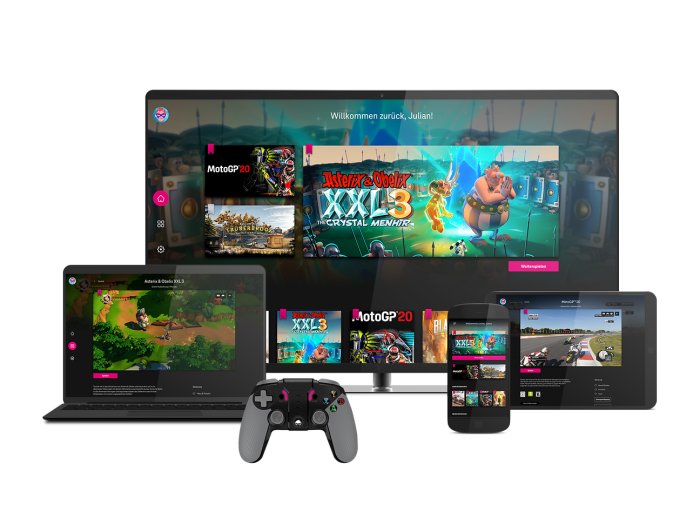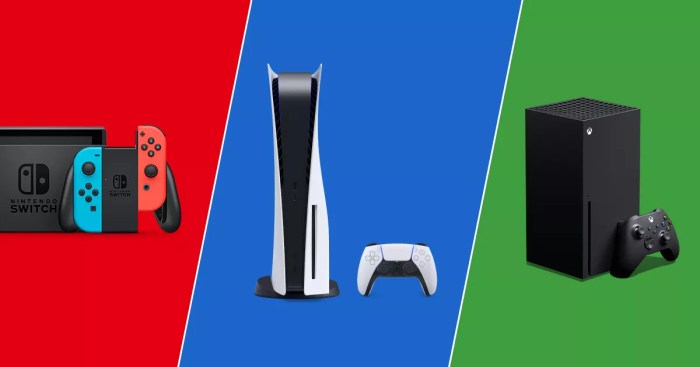Gaming platforms are everywhere, shaping how we play and interact. From the classic console experience to the ever-evolving world of mobile and cloud gaming, the landscape is constantly shifting. This exploration dives into the different types of platforms, their business models, historical evolution, user experiences, and societal impact, painting a complete picture of this dynamic industry.
We’ll cover everything from the technical specs of leading platforms like PlayStation, Xbox, and PC gaming to the impact of microtransactions and the rise of esports. We’ll also look ahead, predicting future trends and exploring the ethical considerations that come with such a powerful and pervasive form of entertainment.
Types of Gaming Platforms

The gaming landscape is incredibly diverse, offering a wide array of platforms catering to different preferences, budgets, and technical capabilities. From the immersive experience of a home console to the portability of mobile gaming and the power of PC gaming, the choice is vast. Understanding the nuances of each platform is key to appreciating the breadth of the gaming world.
Console Gaming Platforms
Console gaming remains a dominant force in the industry, characterized by dedicated hardware designed specifically for gaming. This leads to optimized performance and a streamlined user experience. Major players include Sony (PlayStation), Microsoft (Xbox), and Nintendo (Nintendo Switch). Sony’s PlayStation, with its strong focus on exclusive AAA titles and high-fidelity graphics, targets a broad audience, from casual gamers to hardcore enthusiasts.
Microsoft’s Xbox, known for its robust online services and game pass subscription model, appeals to a wide range of players, emphasizing both single-player and multiplayer experiences. Nintendo, on the other hand, often focuses on family-friendly titles and innovative gameplay mechanics, attracting a diverse audience including families and casual gamers. Market share fluctuates yearly, but these three consistently hold the largest portions of the console market.
PC Gaming Platforms
PC gaming offers unparalleled flexibility and customization. Gamers can tailor their setups to meet their specific needs and budgets, ranging from budget-friendly builds to high-end, powerful machines. This platform is known for its vast library of games, encompassing both AAA titles and a massive selection of indie games. Major players are not individual companies but rather component manufacturers like Intel, AMD, and Nvidia, whose processors and graphics cards dictate much of the PC gaming experience.
The target audience is diverse, ranging from budget-conscious players to hardcore enthusiasts who prioritize high frame rates and maximum graphical fidelity. The open nature of the platform also fosters a strong modding community, extending the lifespan and replayability of many games.
Mobile Gaming Platforms
Mobile gaming has exploded in popularity, fueled by the widespread adoption of smartphones and tablets. This platform prioritizes accessibility and portability, allowing players to enjoy games on the go. Major players include Apple (iOS) and Google (Android), which control the respective operating systems. The target audience is massive and incredibly diverse, encompassing casual gamers, mobile-first gamers, and even hardcore gamers who appreciate the convenience of mobile gaming.
The accessibility of mobile gaming has also led to a boom in free-to-play titles, often incorporating in-app purchases.
Cloud Gaming Platforms
Cloud gaming offers a unique approach, allowing players to stream games directly to their devices without the need for powerful hardware. This eliminates the need for expensive gaming PCs or consoles, making gaming more accessible. Major players include Stadia (now defunct), GeForce Now, and Xbox Cloud Gaming. The target audience is broad, including those with limited budgets, those who prefer to game on less powerful devices, or those who want to access a large library of games without the hassle of downloads.
The reliance on a stable internet connection is a key factor influencing its accessibility and appeal.
Arcade Gaming Platforms
While less prevalent than other platforms, arcade gaming still holds a niche appeal. This platform traditionally features dedicated arcade cabinets found in entertainment venues, offering a unique social and immersive experience. Major players are limited but include companies that manufacture and distribute these cabinets. The target audience is primarily focused on those seeking a social gaming experience or a nostalgic trip back to classic arcade games.
Platform Comparison
| Platform | Release Year (First iteration) | Key Features | Dominant Genres |
|---|---|---|---|
| PlayStation 5 | 2020 | High-fidelity graphics, fast loading times, haptic feedback | Action-adventure, RPG, shooters |
| Xbox Series X | 2020 | High-performance hardware, Game Pass subscription, backward compatibility | Action-adventure, RPG, shooters, racing |
| High-End PC (Example Build) | N/A (Constantly evolving) | Customizable hardware, high frame rates, modding capabilities, vast game library | All genres, strong representation in strategy, simulation, and esports titles |
Business Models of Gaming Platforms

The gaming industry boasts a diverse range of business models, each with its own strengths and weaknesses in attracting and retaining players, ultimately impacting revenue streams. Understanding these models is crucial for both platform developers and investors. The most prevalent models revolve around different approaches to monetization and user acquisition.
Subscription Models
Subscription models offer players access to a library of games or features for a recurring fee. This provides a predictable revenue stream for the platform, allowing for consistent investment in content and infrastructure. Examples include Xbox Game Pass and PlayStation Plus. The advantages include stable income and increased player loyalty due to the value proposition of ongoing access.
However, attracting new subscribers can be challenging, and the subscription price needs to be carefully balanced against the value offered to avoid churn. Retention strategies, such as regular content updates and exclusive benefits, are critical for success.
Free-to-Play Models
Free-to-play (F2P) models allow players to access the core game for free, generating revenue through in-app purchases (IAPs) such as cosmetic items, power-ups, or expansions. This model has become extremely popular due to its low barrier to entry, attracting a large player base. The success of F2P hinges on the design of the IAP system; it needs to be balanced to avoid feeling exploitative while generating sufficient revenue.
Candy Crush Saga and Fortnite are prime examples of successful F2P games. However, F2P models can struggle with player retention if the IAPs are perceived as pay-to-win, driving away players who feel unfairly disadvantaged. Careful game design and a well-thought-out monetization strategy are essential.
Premium Models
Premium models require players to purchase the game upfront for a one-time fee. This model provides a straightforward revenue stream and often leads to a higher perceived value of the game. Examples include many single-player titles and smaller indie games. The advantage is a clear and simple pricing structure. However, the upfront cost can be a barrier to entry for many players, limiting the potential player base compared to F2P models.
Post-launch revenue generation relies on expansion packs or sequels, requiring ongoing development and marketing investment.
Impact of Microtransactions and In-App Purchases
Microtransactions and IAPs have fundamentally reshaped the gaming landscape. They allow for continuous revenue generation beyond the initial purchase, providing developers with sustained funding for updates and new content. However, poorly implemented IAPs can damage player trust and lead to negative reviews, impacting the game’s overall success. The ethical considerations surrounding loot boxes and other potentially addictive IAPs are also a significant concern for the industry.
Successful implementation requires a careful balance between generating revenue and maintaining a positive player experience. The rise of “whales” – high-spending players – is a key factor in the success of many F2P games, but relying too heavily on this segment can make the game less accessible and enjoyable for the majority of players.
Hypothetical Business Model: A Hybrid Approach
A new gaming platform could leverage a hybrid model combining subscription and F2P elements. The platform would offer a core selection of games for free, supported by non-intrusive advertisements and optional cosmetic IAPs. A premium subscription tier would unlock additional games, remove advertisements, provide exclusive content, and offer early access to new releases. This model aims to maximize user acquisition through the free-to-play aspect while generating consistent revenue through subscriptions and carefully curated IAPs.
The success of this model depends on providing substantial value in both the free and premium tiers, fostering a sense of community and engagement, and avoiding exploitative monetization tactics. This approach, drawing inspiration from successful models like Spotify and Netflix, aims to balance accessibility with revenue generation, creating a sustainable and enjoyable gaming experience for a broad player base.
The predicted outcome is a large and active player base with a significant portion subscribing to the premium tier, generating a diverse and robust revenue stream.
The User Experience on Gaming Platforms

A positive user experience (UX) is paramount for the success of any gaming platform. It’s the crucial element that keeps players engaged, encourages spending, and fosters a loyal community. A poorly designed platform, regardless of its game library, will struggle to attract and retain players. This section explores the key factors influencing UX in the gaming world, comparing different approaches and highlighting innovative examples.
Factors Contributing to a Positive User Experience, Gaming platforms
Several key factors combine to create a positive UX on gaming platforms. These include intuitive interface design, robust community features that foster interaction and a sense of belonging, and readily available, effective customer support. A well-designed interface should be easy to navigate, visually appealing, and tailored to the platform’s target audience. Community features like in-game chat, forums, and guilds allow players to connect, share experiences, and collaborate.
Finally, responsive and helpful customer support is essential for resolving issues and maintaining player satisfaction. A platform failing in any of these areas risks alienating its user base.
Comparison of User Experiences Across Platforms
Different gaming platforms offer vastly different UX experiences. Steam, for example, prioritizes ease of use and a vast library of games, making it accessible to a wide range of players. Its interface is relatively straightforward, even for newcomers. In contrast, a platform like Discord, while offering excellent community features and communication tools, might present a steeper learning curve for those unfamiliar with its unique structure.
Accessibility features vary significantly; some platforms offer robust options for players with disabilities, while others lag behind. Similarly, the level of social interaction varies, with some platforms emphasizing competitive gameplay and others focusing on collaborative experiences.
Innovative Design Choices Enhancing User Experience
Several gaming platforms have implemented innovative design choices to enhance UX. Epic Games Store’s integration of a built-in social hub, allowing players to connect and share experiences directly within the platform, is one example. Another example is the use of personalized recommendations, as seen on platforms like Netflix and Spotify, but adapted for games. This feature uses data on player preferences to suggest relevant titles, improving discoverability and reducing the time spent searching for games.
Furthermore, some platforms use advanced data analytics to identify and address potential usability issues proactively, continuously refining the user experience.
Steam’s User Interface and its Contribution to Success
Steam’s success is, in no small part, due to its well-designed user interface. Imagine a screenshot of the Steam main page: The left-hand sidebar displays a clear, easily navigable menu for accessing the user’s library, store, community features, and account settings. The main area showcases recently played games, recommended titles based on the user’s history, and current sales.
The top bar provides quick access to search functionality and user notifications. This clean and intuitive layout allows users to quickly find what they need, whether they are looking to launch a game, browse the store, or connect with friends. The consistent visual design elements, such as the use of clear typography and consistent iconography, contribute to a cohesive and user-friendly experience.
This focus on usability and ease of navigation has been a key driver in Steam’s dominance as a leading PC gaming platform.
The Impact of Gaming Platforms on Society

Gaming platforms have profoundly reshaped modern society, impacting social interactions, cultural norms, and ethical considerations. Their influence extends far beyond simple entertainment, creating both opportunities and challenges that require careful examination. This section will explore the multifaceted impact of these platforms, highlighting both the positive and negative consequences.Gaming Platforms and Social InteractionGaming platforms have become significant hubs for social interaction, fostering communities built around shared interests and experiences.
Online multiplayer games, for example, allow players from diverse geographical locations to collaborate, compete, and build relationships. This can lead to the formation of strong social bonds, a sense of belonging, and the development of teamwork and communication skills. However, this online interaction can also lead to negative consequences such as cyberbullying, harassment, and the creation of echo chambers where extreme viewpoints are reinforced.Ethical Considerations Surrounding Gaming PlatformsThe rise of gaming platforms also presents several ethical challenges.
One major concern is game addiction, which can lead to detrimental effects on mental and physical health, academic performance, and social relationships. Studies have shown a correlation between excessive gaming and symptoms of depression and anxiety. Another significant ethical issue is the potential for violence in video games and its impact on players’ behavior. While the causal link between violent video games and real-world aggression remains a subject of ongoing debate, concerns persist about the potential desensitization to violence and the normalization of aggressive behavior.
Finally, accessibility remains a crucial ethical concern. Ensuring that gaming platforms are inclusive and accessible to individuals with disabilities requires careful consideration of design and technological advancements.Societal Impacts of Gaming Platforms: A SummaryThe following table summarizes the positive and negative societal impacts of gaming platforms:
| Positive Impacts | Negative Impacts |
|---|---|
| Fosters community and social interaction | Addiction and mental health issues |
| Develops cognitive skills (problem-solving, strategy, etc.) | Exposure to violence and potentially harmful content |
| Provides opportunities for creative expression and collaboration | Cyberbullying and online harassment |
| Creates economic opportunities through game development and esports | Issues of accessibility and inclusivity |
General Inquiries: Gaming Platforms
What’s the difference between cloud gaming and console gaming?
Cloud gaming streams games to your device, needing only a good internet connection, while console gaming requires a dedicated console and game discs or downloads.
Are all free-to-play games riddled with microtransactions?
Nope, many free-to-play games offer a completely enjoyable experience without requiring any purchases, while others utilize microtransactions for cosmetic items or optional boosts.
How do gaming platforms make money?
They use various models: selling games directly (premium), subscriptions (like Xbox Game Pass), and in-app purchases (microtransactions) in free-to-play games.
What are some emerging trends in gaming platforms?
Big trends include cross-platform play, the expansion of VR/AR integration, and the continued growth of cloud gaming services.
